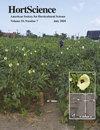利用幼根根快速筛选李抗蜜环菌根腐病基因型
IF 1.6
3区 农林科学
Q2 HORTICULTURE
引用次数: 0
摘要
蜜环菌根腐病(ARR)是由蜜环菌和tabescens脱蜜环菌引起的一种严重影响美国核桃树的病害。减轻这种疾病影响的一个策略是发展抗arr的砧木。然而,目前筛选李属植物抗ARR的技术耗时耗力,而且可能无法完全复制田间条件。为了解决这些局限性,我们开发了一种新的快速体外筛选方法,该方法使用了2岁的李树砧木基因型的根。我们在体外筛选了12个李树基因型对蜜环菌、蜜环菌和tabescens脱蜜环菌的抗性。新挖掘的根段被放置在真菌培养物旁边或上面。21 d后,测定真菌定殖的周向百分比和水平长度以及真菌进入根周皮的能力。还评估了感染周围的根组织,以评估对ARR病原体的任何反应。结果表明,接种后的李树根组织有真菌侵染的迹象,不同基因型的侵染和寄主反应不同。宿主的反应与在田间观察到的类似,如感染组织与屏障区区隔化、坏死性表皮的形成和根表面愈伤组织的形成,在较不敏感的基因型中观察到的更为明显。总之,我们新开发的检测方法使用2年砧木新挖的根,可以快速筛选李对ARR的抗性基因型。本文章由计算机程序翻译,如有差异,请以英文原文为准。
Rapid In Vitro Screening of Prunus Genotypes for Resistance to Armillaria Root Rot Using Roots of Young Rootstocks
Armillaria root rot (ARR), caused by Armillaria species and Desarmillaria tabescens, is a severe disease that affects stone fruit trees in the United States. One strategy to mitigate the impact of this disease is to develop ARR-resistant rootstocks. However, current techniques to screen Prunus species for resistance to ARR are time-consuming, labor-intensive, and may not fully replicate field conditions. To address these limitations, we developed a new rapid in vitro screening assay, which uses roots of 2-year-old Prunus rootstock genotypes. We screened 12 Prunus genotypes against Armillaria mellea, Armillaria solidipes, and Desarmillaria tabescens in vitro. Freshly excavated root segments were placed next to or on top of fungal cultures. After 21 days, the circumferential percentage and horizontal length of the fungal colonization and the ability of the fungus to enter through root periderm were evaluated. The root tissue surrounding the infection was also evaluated to assess any response reactions against the ARR pathogens. Our results showed that inoculated root tissues displayed signs of fungal infection, and infection and host responses varied among the Prunus genotypes. Host responses similar to those observed in the field, such as compartmentalization of infected tissue with barrier zones, necrophylactic periderm formation, and callus formation on root surfaces, were observed and were more evident in less susceptible genotypes. In conclusion, our newly developed assay, which uses freshly excavated roots from 2-year-old rootstocks, can rapidly screen Prunus genotypes for resistance to ARR.
求助全文
通过发布文献求助,成功后即可免费获取论文全文。
去求助
来源期刊

Hortscience
农林科学-园艺
CiteScore
3.00
自引率
10.50%
发文量
224
审稿时长
3 months
期刊介绍:
HortScience publishes horticultural information of interest to a broad array of horticulturists. Its goals are to apprise horticultural scientists and others interested in horticulture of scientific and industry developments and of significant research, education, or extension findings or methods.
 求助内容:
求助内容: 应助结果提醒方式:
应助结果提醒方式:


